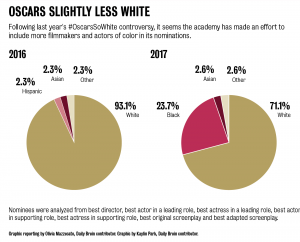Diversity in film and television came into the spotlight in 2016 with #OscarsSoWhite. A USC study in 2016 found only about a quarter of speaking characters belonged to nonwhite racial groups. In “Reel Representation,” columnist Olivia Mazzucato discusses different issues of race and representation in media as they relate to new movies and TV shows.
#OscarsSoWhite isn’t over.
#OscarsSoWhite has trended for the past two years across social media when the nominations for the Academy Awards were announced. The term was coined by blogger April Reign, inspired by the fact that the acting categories were dominated by white actors in 2015 and 2016. The hashtag has come to shape media discussion and analysis of race and the Oscars.
This year, seven different actors of color garnered nominations out of 20 total acting nominations. The often forgotten category of best documentary feature generated buzz because four of the five nominated films were created by black directors. Article headlines boldly proclaimed “R.I.P. #OscarsSoWhite” and “Diverse picks break #OscarsSoWhite.”
#OscarsSoWhite is neither dead nor broken. The general public and media need to resist the urge to take this year’s increased diversity as a sign that the fight has been won. While progress has been made, it’s important to recognize the larger issue – the Oscars are representative of an overall lack of diversity throughout Hollywood.
[Read more: ‘Hidden Fences’ gaffe depicts worrying outlook on representation]
I don’t want to diminish the importance of the advancements that were made this year. The fact that so many actors of color were recognized, like Ruth Negga in “Loving” and Mahershala Ali in “Moonlight,” is a form of improvement. One of the most important components of diversity is having a multitude of complex stories told, with a variety of people – from aspiring female scientists of color to young gay boys – enabling people to see someone who looks like themselves on screen. In some ways, on-screen diversity was accomplished this year.
This year’s diversity was limited in terms of the awards categories. While there were certainly more actors of color, most creative categories remained largely white. The best original screenplay category is comprised only of white screenwriters, which means that the words and voices of people of color are conspicuously missing from the films being honored this year. For best picture, only a few of the producers, including Pharrell Williams of “Hidden Figures” and Kimberly Steward of “Manchester by the Sea,” are people of color. Both of these trends largely follow across other categories.
[Read more: Oscars 2017]
But even within the racial minorities represented in the nominations lies a distinct lack of representation. Of the seven actors of color nominated in the four acting categories, Dev Patel is the only Asian actor to have received a nomination, and none of the other acting nominees are Indian-American, Pacific Islander, Hispanic or Middle Eastern.
Acknowledging strides in diversity is easy if one looks at the Oscar nominations in a certain way – looking at more visible categories, such as acting. But taking into account all the nominations, clearly not much has changed in terms of representation.
The academy cannot nominate films that don’t exist. It cannot laud actors that haven’t been cast or praise dialogue that hasn’t been written. It’s not the nominations that are lacking – it’s the film industry as a whole.
#OscarsSoWhite gives people a place to vent their frustration, a target on which to focus their anger in a perfectly worded 140-character tweet. But in reality, using the hashtag vilifies the academy without pinning down a main culprit for lack of diversity, which is an issue that pervades the industry as a whole.
The Oscars are the end result of a broken cinematic system. The Academy Awards can’t change unless change happens further down in the creative pipeline. Change will only occur at the Oscars when a shift from whiteness to inclusion occurs at the studio level. As individuals, the most important thing we can do is continue to use the hashtag to draw attention to the issue.
To relegate #OscarsSoWhite as a topic of the past is to ignore the overarching issues of access and visibility that resulted in the hashtag in the first place. A small increase in diverse nominations doesn’t solve the racial underpinnings and pitfalls of the industry overnight.
[Oscars 2017: UCLA alum reflects on stuntwoman role in ‘La La Land’]
The lack of recognition and opportunity for female directors shows that Hollywood already has a tendency to package ideas into a to-do list, ready to be checked off when completed and subsequently forgotten. Kathryn Bigelow was the first woman to win the award for best director in 2010. Since then, not a single woman has been nominated in the category.
We as an audience cannot let the same thing happen to #OscarsSoWhite.

